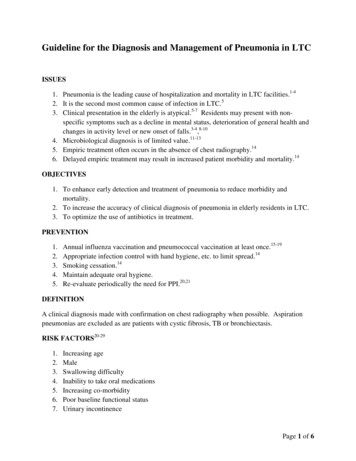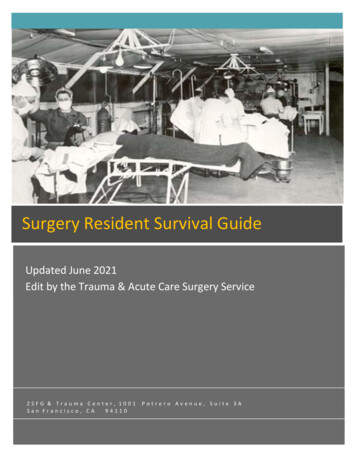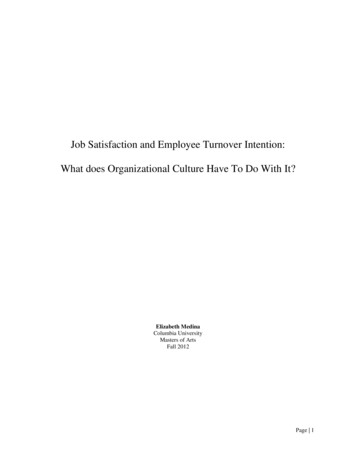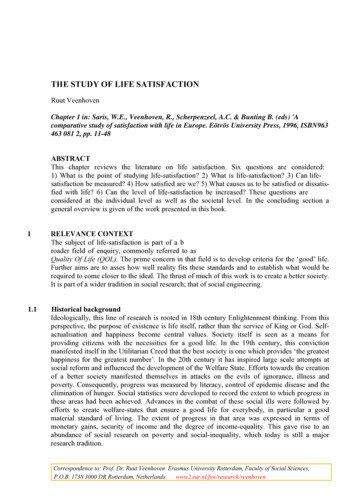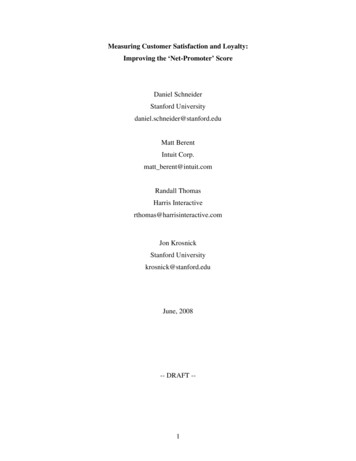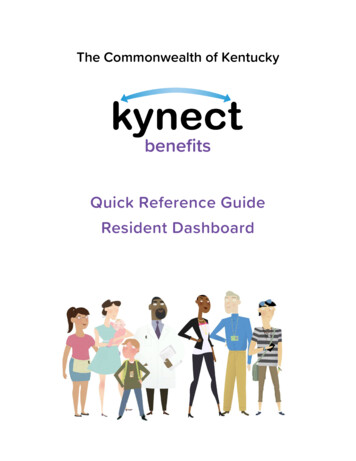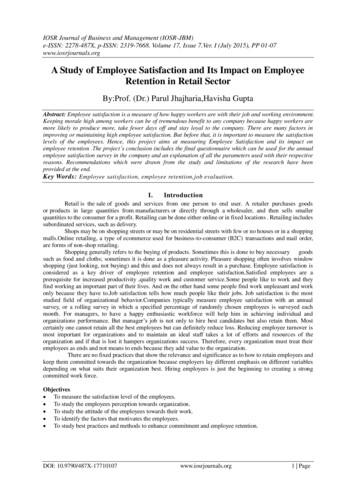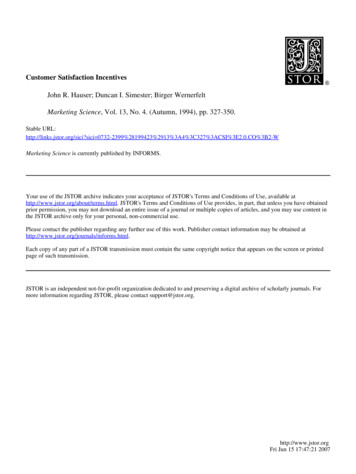
Transcription
Improving Resident Satisfaction with Post-HospitalizationFollow-up at Mayo Clinic FloridaMegan Melody1 , Samantha Espinosa1 , Karl Mareth1 , Lindsay Gardner1 , AlexanderHeckman1 , Annamaria Mechtler1 , SeQuoya Killebrew1 , Matthew Dudgeon1 , RichardWhite1 , and Leigh Speicher11Mayo Clinic FloridaPosted on Authorea 11 May 2020 — CC-BY 4.0 — https://doi.org/10.22541/au.158921583.30982457 — This a preprint and has not been peer reviewed. Data may be preliminary.May 11, 2020AbstractRationale, aims, and objectives: Post-hospitalization follow-up within 30 days following discharge has been shown to positivelyimpact time to readmission, healthcare costs, and patient self-reported adherence and satisfaction. We aimed to improveresident satisfaction with the process of establishing post-hospitalization, primary care provider (PCP) follow-up. Methods:In this quality improvement study we surveyed all internal medicine residents at our institution regarding their satisfactionwith the process of establishing PCP follow-up at the time of hospital discharge. A streamlined process was developed andtwo subsequent interventions were enacted; a dedicated teaching session and distribution of pocket cards outlining the process.Residents were then surveyed following each intervention to assess for impact on overall satisfaction and burden of work. Results:Initially, 77.3% of residents were not satisfied with the process of establishing post-hospitalization PCP follow-up. Following thefirst intervention there was a trend towards increasing satisfaction rates by 16.7% (p 0.20), and after the second interventionthere was a statistically significant increase in satisfaction rates from baseline by 44% (p 0.007). There was also a reductionin the feeling of workload burden associated with establishing PCP follow-up from 32% to 25%, and over 67% of participantseither agreed or strongly agreed that the workload was not too burdensome. Conclusion: This quality improvement initiativeestablished that resident physicians at our institution previously found the process of establishing PCP follow-up at the timeof patient discharge both confusing and burdensome. Through the implementation of our interventions we were able to achieveour aims of improving resident satisfaction.Improving Resident Satisfaction with Post-Hospitalization Follow-up at Mayo Clinic FloridaIntroduction:The transition from inpatient medical care to the outpatient setting is a high risk time for patients and reliesheavily on communication and coordination of medical care across multiple settings1-4 . Studies have shownthat patients who receive follow-up medical care within the first 30-days following hospital discharge havedecreased readmission rates, decreased health care costs, and improved medical adherence and satisfaction4-6. However, literature shows that communication between hospital physicians and primary care providers(PCP) occurs infrequently (only 3%-20%) and only 56% of PCPs were satisfied with communication withhospitalists2,3,7-12 . Improvements in provider satisfaction have been seen with the utilization of pre-formattedelectronic communication, computer generated discharge summaries, and standardized processes to improvethe coordination of care1-3,11,13-16 . Our quality improvement project was undertaken after it was observedthat there was no standardized process for scheduling a patient’s PCP follow-up appointment at the time ofhospital discharge, causing increase burden of workload for the resident and leading to dissatisfaction. Ouraim was to improve resident satisfaction rating of the post-hospitalization PCP follow-up process by 10%over the course of nine months, without increasing resident perception of workload or burden.1
Posted on Authorea 11 May 2020 — CC-BY 4.0 — https://doi.org/10.22541/au.158921583.30982457 — This a preprint and has not been peer reviewed. Data may be preliminary.Methods:Our team conducted a prospective quality improvement project with the specific intention to evaluate andimprove a specific practice or program, which per institutional guidance was exempt from InstitutionalReview Board review. Utilizing an online survey generator, Survey Monkey , we sent a link via email foran anonymous survey to 49 internal medicine residents. The survey consisted of one question identifying theresident’s year of training, two Likert-scale questions, and four open-answer questions (Figure 1) to assessbaseline resident satisfaction and workload burden associated with establishing PCP follow-up at the timeof patient discharge from the hospital. Following the results of the first survey, our team identified factorsleading to dissatisfaction among residents in the discharge planning process (Figure 2) and created a flowdiagram outlining the current process for establishing PCP follow-up at the time of discharge (Figure 3).Our team then worked within the confines of our current electronic medical record (EMR) system to createa standardized, streamlined process for establishing patient follow-up at the time of discharge. This processincluded step-by-step instructions to locate PCP information in the chart; provide patient with dischargeinstructions; order follow-up appointments, labs, and tests; and communicate with PCPs both inside andoutside of our institution’s healthcare network. Our first intervention, an instructional conference held atresident noon conference, outlined this new streamlined process. Six weeks after the educational session, asecond, four-question survey was sent to 49 residents, using the same method as previously outlined. Thissurvey again contained one question identifying the resident’s year of training, the same two Likert-scalequestions, and one multiple choice question to assess whether the resident had attended the teaching session.For our second quality improvement intervention, pocket cards (Figure 4) were distributed to residents viaemail and hung on the wall of all inpatient resident work stations. Following the second intervention, a third,five-question, anonymous survey was sent to all internal medicine residents. This survey again contained onequestion identifying the resident’s year of training, the same two Likert-scale questions, one multiple choicequestion to assess whether the resident had attended the initial teaching session, and an additional multiplechoice question to assess whether the resident had referenced the instructional pocket cards. Data from allsurveys were compiled using Survey Monkey software and exported to excel for statistical analysis. Dataanalysis was completed using the Mann Whitney U test.Results:The initial survey had a 45% resident response rate (22 of 49). Of these residents, five (22.7%) were satisfiedwith the post-hospitalization primary care follow-up process, 11 (50%) were neither satisfied nor dissatisfied,and six (27.3%) were dissatisfied (Figure 5).There was a large variation in responses to the free text question asking residents to identify their role inestablishing post-hospitalization PCP follow-up. Some residents identified their primary role as communicating with the patients’ PCP, with responses such as “letter to PCP”, “call outside PCP”, “route dischargesummary to their (patient’s) PCP’s fax”, or “messaging the PCP to let them know that their patient washospitalized”. Other residents identified their primary role as ordering, or placing a request for, follow-upappointments with the following responses: “placing an order on discharge”, “usually request follow-up butnot involved in scheduling”, “putting in the order”, and “placing an order and hoping it happens”. Lastly,some residents stated that their role in post-hospitalization follow-up was to advise the patient to contacttheir PCP office to independently make follow-up appointments with responses including: “collect the PCPinformation and put it in the patient discharge instructions”, “making sure the patient knows to ask outsidePCP for appointment”, “advise the patient to see their own PCP within the week”, and “let the patientschedule their own follow-up”. In response to the question “What aspects of the post-hospitalization primarycare follow up process work well?” residents primarily identified one component, with nine out of the 21 freetext responses stating that establishing patient follow-up was much easier within the Mayo Clinic HealthCare Network. Another six out of the 21 residents responded with variations of “I don’t know” or “I am notsure”.Twenty residents provided free text responses to the question “What aspects of the post-hospitalization primary care follow-up process don’t work well”? Residents identified difficulty in communicating with PCPs2
(especially when outside the Mayo network), incomplete documentation or difficulty finding documentationof patients’ PCP information in the EMR, and uncertainty about whether follow-up appointments actuallyoccur. Of the 17 residents who answered the question “What do you think would improve how arrangements are made for PCP follow-up?”, six residents suggested increased administrative support, five residentsdescribed standardized order sets and protocols, four residents recommended improved means for communication with PCP, one resident asked for clearer documentation of patient’s PCP contact information, andone resident was unsure.Posted on Authorea 11 May 2020 — CC-BY 4.0 — https://doi.org/10.22541/au.158921583.30982457 — This a preprint and has not been peer reviewed. Data may be preliminary.Following our first intervention, 34 out of 49 residents (69.4%) responded to the survey and, although notstatistically significant, there was an improvement when compared to the initial survey by 16.7% (p 0.20).Two residents (6.1%) reported being very satisfied with the process, 11 (33.3%) satisfied, 14 (42.4%) neithersatisfied nor dissatisfied, and 6 (18.2%) dissatisfied (Figure 5). Following our second intervention, 12 of the49 residents (24%) responded to the third survey. There was a statistically significant increase in satisfactionrates from baseline by 44% (p 0.007). Two out of twelve (16.7%) responding residents reported beingvery satisfied with the post-hospitalization primary care follow-up process, six (50%) satisfied, four (33.3%)neither satisfied nor dissatisfied, and zero residents reported being dissatisfied or very dissatisfied (Figure 5).Prior to any intervention, the baseline survey showed only one out of 22 (4.5%) responding residents stronglyagreed that the time and workload associated with establishing primary care follow-up post hospitalizationwas not too burdensome. Seven out of 22 (31.8%) agreed, seven (31.8%) neither disagreed or agreed, and seven(31.8%) disagreed (Figure 6). Following the first intervention there was no increase in perceived workloadburden (p 0.58). Three of 34 (8.8%) residents strongly agreed that the workload was not too burdensome,14 (41.2%) agreed, six (17.6%) neither agreed nor disagreed, 10 (29.4%) disagreed, and one (2.9%) stronglydisagreed (Figure 6). After the second intervention, there again was no increase in perceived workload burdenfrom baseline (p 0.19). Two out of 12 residents (16.7%) strongly agreed, six (50%) agreed, one (8.3%) neitheragreed nor disagreed, three (25%) disagreed, and zero residents strongly disagreed (Figure 6).Discussion:Timely post-hospitalization follow-up has been shown to significantly reduce hospital readmission rates 1,4-6 .Transition of patient care from the inpatient to the outpatient setting can lead to missed test results, medicalerrors, and both patient and provider dissatisfaction in the discharge process 7-9,17-19 . Our initial baselineresident survey identified areas of resident dissatisfaction with the discharge planning process to include:confusion about the residents’ role, difficulty in communication, and lack of a standardized process forestablishing PCP follow-up. We conducted a prospective quality improvement initiative to improve residentphysician satisfaction with establishing post-hospitalization PCP follow-up.In an effort to elicit unbiased responses all survey responses were anonymous without the ability to retrospectively link resident responses with identifying information. For the first two surveys, our team was able toachieve acceptable resident response rates, with 45% and 65% of all internal medicine residents responding,respectively. Although there was a statistically significant increase in resident satisfaction rates from theinitial survey to the last survey, the response rate to the last survey was significantly lower than the priortwo surveys with only 24% of residents responding. Response rates to the final survey may be attributedto alert or email fatigue, as this was a longitudinal process requiring resident participation throughout thelength of nearly an entire academic year 20-22 .Our team was able to utilize our current hospital and clinic infrastructure and work within the technological confines of our current EMR to develop a standardized and streamlined process for establishing posthospitalization PCP follow-up. This process also included pathways to augment follow-up with both PCPswithin our clinic system and PCPs at outside institutions. Through the use of two simple interventionsfocused on provider education, we were able to implement this new method at no additional cost to ourinstitution. However, the ongoing use of this standardized process will require continued efforts from ourquality improvement team or additional support from our institution. As current trainees graduate and newtrainees enter into the residency program each year, there will need to be annual educational sessions to3
inform new residents of this process. Additionally, each resident will need to be provided the instructionalpockets cards, whether via e-mail or in print, each year and the pocket cards at resident work-stations willneed to be maintained.Posted on Authorea 11 May 2020 — CC-BY 4.0 — https://doi.org/10.22541/au.158921583.30982457 — This a preprint and has not been peer reviewed. Data may be preliminary.Although this initiative was able to show an improvement in resident physician satisfaction, the interventionand analysis were limited to a small subset of resident physicians within one department and at only oneacademic medical center. This project did not evaluate if senior physicians and faculty or providers inother specialties encounter the same baseline dissatisfaction with establishing post-hospitalization follow-up.In addition, the trainees involved in this quality improvement project have time each day designated foreducation, making our interventions of provider education easier to implement. It is unclear whether thisinitiative, if expanded hospital wide, would have as high a yield of participation and therefore, as significantan impact on overall provider satisfaction. However, the consolidated process that we identified relied highlyon tools already built into the EMR, so it is likely that this process could be more easily generalized to otherservices and departments at our institution or others hospitals.Conclusion: This quality improvement initiative identified factors contributing to resident dissatisfactionwith the process of establishing post-hospitalization PCP follow-up. The implementation of a standard andstreamlined process resulted in a statistically significant increase in resident satisfaction with establishingPCP follow-up at the time of hospital discharge without an increase in perceived workload burden. Furtherefforts are required to continue the utilization of this process and to assess if this same process can increaseprovider satisfaction across all levels of training and specialties.References:1. Herzig SJ, Schnipper JL, Doctoroff L, et al. Physician Perspectives on Factors Contributing to Readmissions and Potential Prevention Strategies: A Multicenter Survey. J Gen Intern Med.2016;31(11):1287-1293.2. Holleck JL, Gunderson CG, Antony SM, et al. The ”Hand-in” Project: Jump-starting CommunicationBetween Inpatient and Outpatient Providers.South Med J. 2017;110(11):694-698.3. Jones CD, Vu MB, O’Donnell CM, et al. A failure to communicate: a qualitative exploration of carecoordination between hospitalists and primary care providers around patient hospitalizations. J Gen InternMed. 2015;30(4):417-424.4. Misky GJ, Wald HL, Coleman EA. Post-hospitalization transitions: Examining the effects of timing ofprimary care provider follow-up.J Hosp Med. 2010;5(7):392-397.5. Lee KK, Yang J, Hernandez AF, Steimle AE, Go AS. Post-discharge Follow-up Characteristics AssociatedWith 30-Day Readmission After Heart Failure Hospitalization. Med Care. 2016;54(4):365-372.6. Odeh M, Scullin C, Fleming G, Scott MG, Horne R, McElnay JC. Ensuring continuity of patient care acrossthe healthcare interface: Telephone follow-up post-hospitalization. Br J Clin Pharmacol.2019;85(3):616-625.7. Davis MM, Devoe M, Kansagara D, Nicolaidis C, Englander H. ”Did I do as best as the system would letme?” Healthcare professional views on hospital to home care transitions. J Gen Intern Med.2012;27(12):16491656.8. Graumlich JF, Novotny NL, Nace GS, Aldag JC. Patient and physician perceptions after software-assistedhospital discharge: cluster randomized trial. J Hosp Med. 2009;4(6):356-363.9. Graumlich JF, Novotny NL, Stephen Nace G, et al. Patient readmissions, emergency visits, and adverseevents after software-assisted discharge from hospital: cluster randomized trial.J Hosp Med. 2009;4(7):E11-19.10. Kripalani S, Jackson AT, Schnipper JL, Coleman EA. Promoting effective transitions of care at hospitaldischarge: a review of key issues for hospitalists. J Hosp Med. 2007;2(5):314-323.11. Kripalani S, LeFevre F, Phillips CO, Williams MV, Basaviah P, Baker DW. Deficits in communicationand information transfer between hospital-based and primary care physicians: implications for patient safety4
and continuity of care. JAMA. 2007;297(8):831-841.12. Nguyen OK, Kruger J, Greysen SR, Lyndon A, Goldman LE. Understanding how to improve collaborationbetween hospitals and primary care in postdischarge care transitions: a qualitative study of primary careleaders’ perspectives. J Hosp Med. 2014;9(11):700-706.13. Burke RE, Kripalani S, Vasilevskis EE, Schnipper JL. Moving beyond readmission penalties: creating anideal process to improve transitional care. J Hosp Med. 2013;8(2):102-109.14. Lang E, Afilalo M, Vandal AC, et al. Impact of an electronic link between the emergency departmentand family physicians: a randomized controlled trial. CMAJ. 2006;174(3):313-318.15. Motamedi SM, Posadas-Calleja J, Straus S, et al. The efficacy of computer-enabled discharge communication interventions: a systematic review. BMJ Qual Saf. 2011;20(5):403-415.16. Samal L, Dykes PC, Greenberg J, et al. The current capabilities of health information technology tosupport care transitions. AMIA Annu Symp Proc. 2013;2013:1231.Posted on Authorea 11 May 2020 — CC-BY 4.0 — https://doi.org/10.22541/au.158921583.30982457 — This a preprint and has not been peer reviewed. Data may be preliminary.17. Callen J, Georgiou A, Li J, Westbrook JI. The safety implications of missed test results for hospitalisedpatients: a systematic review.BMJ Qual Saf. 2011;20(2):194-199.18. Leppin AL, Gionfriddo MR, Kessler M, et al. Preventing 30-day hospital readmissions: a systematicreview and meta-analysis of randomized trials. JAMA Intern Med. 2014;174(7):1095-1107.19. Moore C, Wisnivesky J, Williams S, McGinn T. Medical errors related to discontinuity of care from aninpatient to an outpatient setting.J Gen Intern Med. 2003;18(8):646-651.20. Adams MJD, Umbach PD. Nonresponse and Online Student Evaluations of Teaching: Understanding theInfluence of Salience, Fatigue, and Academic Environments. Research in Higher Education. 2012;53(5):576591.21. Ancker JS, Edwards A, Nosal S, et al. Effects of workload, work complexity, and repeated alerts on alertfatigue in a clinical decision support system. BMC Medical Informatics and Decision Making.2017;17(1):36.22. Baseman JG, Revere D, Painter I, Toyoji M, Thiede H, Duchin J. Public health communications andalert fatigue. BMC Health Services Research. 2013;13(1):295.Acknowledgements : The authors thank the Internal Medicine Residency Program at Mayo Clinic Florida,the Office of Quality Improvement Scholarship at Mayo Clinic, Dr. Colt Cowdell, and Dr. John Matulis forthe support of this quality improvement initiative.Conflict of Interest Statement : Each of the authors confirms that this manuscript has not been previouslypublished and is not currently under consideration by any other journal. Each named author has substantiallycontributed to conducting the underlying research and drafting this manuscript. Additionally, all of thenamed authors have no conflict of interest, financial or otherwise.Figures:Figure 1. Initial resident survey.5
Posted on Authorea 11 May 2020 — CC-BY 4.0 — https://doi.org/10.22541/au.158921583.30982457 — This a preprint and has not been peer reviewed. Data may be preliminary.Figure 2. Fishbone diagram identifying factors leading to dissatisfaction amongst residents in the dischargeplanning process.6
Posted on Authorea 11 May 2020 — CC-BY 4.0 — https://doi.org/10.22541/au.158921583.30982457 — This a preprint and has not been peer reviewed. Data may be preliminary.Figure 3. Flow diagram outlining initial process of establishing PCP follow-up at the time of discharge.Figure 4. Pocket card outlining the streamlined process, using the current electronic medical record system,to effectively communicate with the patient’s PCP and establish follow-up appointments and tests at thetime of hospital discharge7
Posted on Authorea 11 May 2020 — CC-BY 4.0 — https://doi.org/10.22541/au.158921583.30982457 — This a preprint and has not been peer reviewed. Data may be preliminary.Figure 5. Resident satisfaction with the post-hospitalization primary care follow-up process across all threesurvey time points.8
Posted on Authorea 11 May 2020 — CC-BY 4.0 — https://doi.org/10.22541/au.158921583.30982457 — This a preprint and has not been peer reviewed. Data may be preliminary.Figure 6. Resident perception of workload burden in establishing primary care follow-up across all threesurvey time points.9
Posted on Authorea 11 May 2020 — CC-BY 4.0 — https://doi.org/10.22541/au.158921583.30982457 — This a preprint and has not been peer reviewed. Data may be preliminary.10
Posted on Authorea 11 May 2020 — CC-BY 4.0 — https://doi.org/10.22541/au.158921583.30982457 — This a preprint and has not been peer reviewed. Data may be preliminary.11
Posted on Authorea 11 May 2020 — CC-BY 4.0 — https://doi.org/10.22541/au.158921583.30982457 — This a preprint and has not been peer reviewed. Data may be preliminary.12
Posted on Authorea 11 May 2020 — CC-BY 4.0 — https://doi.org/10.22541/au.158921583.30982457 — This a preprint and has not been peer reviewed. Data may be preliminary.13
Review Board review. Utilizing an online survey generator, Survey Monkey , we sent a link via email for an anonymous survey to 49 internal medicine residents. The survey consisted of one question identifying the resident's year of training, two Likert-scale questions, and four open-answer questions (Figure 1) to assess


